Aaochale ( Let's Go )
Har Ki Dun
देवभूमि उत्तराखण्ड
About Har Ki Dun Trekking
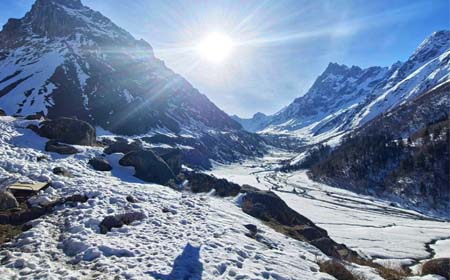
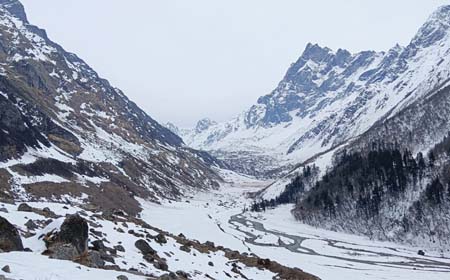
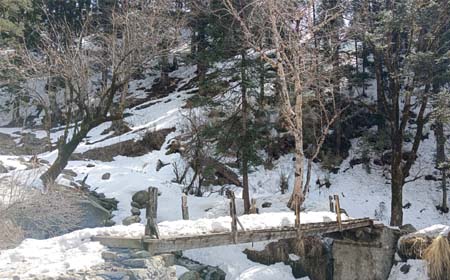
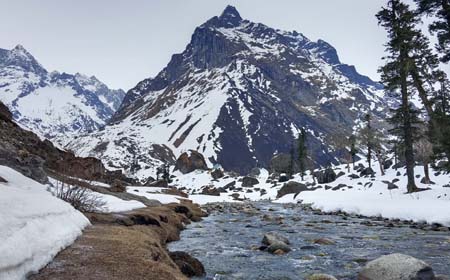


Har Ki Dun Trekking is a beautiful valley located in the Uttarkashi district of Uttarakhand, India. It is situated at an altitude of 3,566 meters (11,712 feet) above sea level and is surrounded by snow-capped peaks, dense forests, and a variety of flora and fauna.
The valley is named after the Har Ki Dun peak, which is one of the most prominent peaks in the region. Har Ki Dun Trekking is considered to be one of the most picturesque and awe-inspiring treks in the Indian Himalayas, attracting trekkers from all over the world.
The trek to Har Ki Dun typically starts from Sankri, a small village located in the Uttarkashi district. The trek is of moderate difficulty and takes around 6-7 days to complete, covering a distance of approximately 47 kilometers (29 miles).
The route takes you through a series of picturesque villages, such as Taluka, Osla, and Seema, where you can interact with the locals and learn about their culture and traditions. The trail also passes through Govind National Park, which is home to a variety of rare and endangered species of flora and fauna.
Once you reach Har Ki Dun, you are greeted by breathtaking views of the surrounding snow-capped peaks and glaciers. The valley is also known for its meadows, which are covered in a carpet of wildflowers during the summer months.
Overall, Har Ki Dun Trekking is a must-visit destination for nature lovers, adventure enthusiasts, and anyone looking for a break from the hustle and bustle of city life.
Who Should Visit Har Ki Dun Valley
Har Ki Dun Trekking is a perfect destination for those who love to explore nature, enjoy hiking, and are looking for an escape from the city’s busy life. The trek to Har Ki Dun is considered to be a moderate trek, and it can be undertaken by people of all ages who are physically fit and have some experience in trekking.
The valley is ideal for adventure enthusiasts, hikers, and nature lovers. It offers some of the most spectacular views of the surrounding peaks, waterfalls, and meadows. The valley is also home to a diverse range of flora and fauna, making it an ideal destination for wildlife enthusiasts and bird watchers.
The trek to Har Ki Dun is also an excellent opportunity for solo travelers or those who want to explore the beauty of the Indian Himalayas. The local people are warm and welcoming, and the Har ki dun trekking offers a chance to interact with them and learn about their culture and traditions.
However, it is important to note that Har Ki Dun Trekking is situated at a high altitude and may not be suitable for people with medical conditions that may be exacerbated by high altitude. It is always recommended to consult a doctor before undertaking any trek at high altitudes.
In summary, Har Ki Dun Trekking is an ideal destination for those who enjoy hiking, nature, and adventure, and are looking to explore the beauty of the Indian Himalayas.
Best Time To Visit Har Ki Dun Valley
The best time to visit Har Ki Dun is during the summer months, from May to June, and again from September to November. During these months, the weather is pleasant, and the skies are clear, providing spectacular views of the surrounding peaks and valleys.
In the summer months, the temperature ranges between 10 to 15 degrees Celsius during the day and may dip to 2 to 5 degrees Celsius during the night. The weather is mostly dry, and the chances of rain are relatively low, making it an ideal time for trekking.
In September to November, the weather is cooler, and the valley is covered with vibrant colors of autumn foliage. During this time, the temperature ranges between 5 to 10 degrees Celsius during the day and may drop to sub-zero levels during the night.
During the winter months, from December to February, the valley is covered in a thick blanket of snow, and the temperature drops significantly. The trek is not recommended during the winter months as the route is covered in snow, and the weather conditions can be harsh.
In summary, the best time to visit Har Ki Dun is during the summer months from May to June and from September to November, when the weather is pleasant, and the skies are clear, providing spectacular views of the surrounding peaks and valleys.
How to Reach Har Ki Dun Valley
Har Ki Dun Trekking is located in the Uttarkashi district of Uttarakhand, India. Here are the different ways to reach Har Ki Dun:
By Air: The nearest airport to Har Ki Dun is the Jolly Grant Airport in Dehradun, which is located around 200 km away from the valley. From the airport, you can hire a taxi or take a bus to Sankri, which is the base camp for the trek to Har Ki Dun.

By Train: The nearest railway station to Har Ki Dun is Dehradun Railway Station, which is around 190 km away from the valley. From the railway station, you can take a taxi or a bus to Sankri, which is the base camp for the trek.

By Road: Sankri is well connected by road with major cities in Uttarakhand. You can take a bus or hire a taxi from Dehradun, Rishikesh, or Mussoorie to reach Sankri. The road journey to Sankri offers beautiful views of the valleys and the snow-capped peaks.

Once you reach Sankri, you can start your Har Ki Dun Trekking. Har ki Dun trekking takes around 6-7 days to complete and covers a distance of approximately 47 km (29 miles). The trek route takes you through a series of picturesque villages, such as Taluka, Osla, and Seema, before you reach Har Ki Dun Trekking.
What To Do in Har ki Dun Valley
Har ki Dun trekking is a beautiful valley situated in the Uttarkashi district of Uttarakhand, India. Here are some of the top things to do in Har ki Dun:
Trekking: The Har Ki Dun trekking is one of the most popular treks in the Indian Himalayas. The trek takes around 6-7 days to complete, covering a distance of approximately 47 km (29 miles). The trek route takes you through a series of picturesque villages, such as Taluka, Osla, and Seema, before you reach Har Ki Doon.

Photography: Har Ki Dun trekking offers stunning views of the surrounding snow-capped peaks, waterfalls, and meadows. The valley is also home to a diverse range of flora and fauna, making it an ideal destination for photography enthusiasts.

Wildlife Watching: The Govind National Park, located near Har Ki Dun, is home to a diverse range of rare and endangered species of flora and fauna. The park is home to animals like Himalayan black bears, snow leopards, musk deer, and bharal (blue sheep).
Camping: Har Ki Dun trekking is an ideal destination for camping. The valley offers several campsites, where you can spend the night under the stars and wake up to the beautiful views of the surrounding peaks.
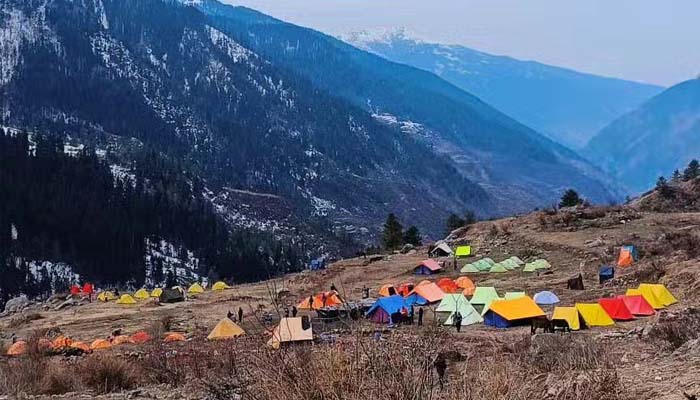
Cultural Exchange: Har Ki Dun trekking is surrounded by several small villages, where you can interact with the local people and learn about their culture and traditions.
Visit the Jaundhar Glacier: The Jaundhar Glacier is located near Har Ki Dun trekking and is a popular attraction. The glacier is surrounded by stunning views of the surrounding peaks and valleys.
In summary, Har Ki Dun trekking offers a range of activities for adventure enthusiasts, nature lovers, and those looking to explore the beauty of the Indian Himalayas.
Places to explore around Har Ki Dun Valley
Har Ki Dun trekking is a beautiful valley in the Uttarkashi district of Uttarakhand, India. Here are some of the top places to explore in and around Har Ki Dun:
Jaundhar Glacier: Jaundhar Glacier is a popular trekking destination located near Har Ki Dun in Uttarkashi district of Uttarakhand, India. The glacier is surrounded by stunning views of the surrounding peaks and valleys, making it a popular destination among adventure enthusiasts and nature lovers.
The trek to Jaundhar Glacier starts from Taluka, which is the starting point of the Har Ki Dun trek. From Taluka, the trek passes through beautiful forests, meadows, and small streams before reaching Osla village. From Osla, the trek passes through the fields and forested areas before reaching the Har Ki Dun valley. After spending some time in Har Ki Dun valley, the trek continues towards Jaundhar Glacier.
The trail to Jaundhar Glacier offers stunning views of the surrounding peaks and valleys. The trek passes through beautiful meadows, moraines, and rocky terrain before reaching the glacier. The glacier is surrounded by stunning views of the peaks and valleys, and is an ideal destination for photography enthusiasts.
The trek to Jaundhar Glacier is moderate to difficult and requires a good level of fitness. The best time to visit Jaundhar Glacier is from April to June and from September to November, when the weather is pleasant and the views are clear.
In summary, Jaundhar Glacier is a beautiful destination located near Har Ki Dun, offering stunning views of the surrounding peaks and valleys, and is a must-visit destination for adventure enthusiasts and nature lovers.
Kedarkantha Trek : Kedarkantha is a beautiful mountain peak located in the Uttarkashi district of Uttarakhand, India. The peak is part of the Himalayan mountain range and is a popular trekking destination among adventure enthusiasts and nature lovers.
The Kedarkantha trek is a popular trekking route that takes around 6-7 days to complete, covering a distance of approximately 20 km (12 miles). The trek starts from Sankri, a small village located in the Uttarkashi district. From Sankri, the trek passes through beautiful forests, meadows, and small streams before reaching the Kedarkantha base camp.
The Kedarkantha trek offers stunning views of the surrounding peaks and valleys. The summit of Kedarkantha offers panoramic views of the surrounding peaks, including Swargarohini, Bandarpoonch, and Kalanag. The trek also passes through beautiful meadows, moraines, and rocky terrain, making it an ideal destination for photography enthusiasts.
The Kedarkantha trek is considered to be a moderate trek and does not require any technical climbing skills. However, the trek requires a good level of fitness, as the trail involves steep ascents and descents.
The best time to visit Kedarkantha is from December to April, when the peak is covered with snow and offers stunning views of the surrounding valleys. However, the trek is also accessible during the summer months from April to June and from September to November, when the weather is pleasant and the views are clear.
In summary, Kedarkantha is a beautiful mountain peak located in Uttarakhand, offering stunning views of the surrounding peaks and valleys, and is a must-visit destination for adventure enthusiasts and nature lovers.
Ruinsara Lake Visit: Ruinsara Lake is a beautiful high-altitude lake located near Har Ki Dun in the Uttarkashi district of Uttarakhand, India. The lake is surrounded by stunning views of the surrounding peaks and valleys, making it a popular destination among adventure enthusiasts and nature lovers.
The trek to Ruinsara Lake starts from Taluka, the starting point of the Har Ki Dun trek. From Taluka, the trek passes through beautiful forests, meadows, and small streams before reaching the Osla village. From Osla, the trail continues through the fields and forested areas before reaching the Har Ki Dun valley. After spending some time in the Har Ki Dun valley, the trek continues towards Ruinsara Lake.
The trail to Ruinsara Lake offers stunning views of the surrounding peaks and valleys. The trek passes through beautiful meadows, moraines, and rocky terrain before reaching the lake. The lake is surrounded by stunning views of the peaks and valleys, and is an ideal destination for photography enthusiasts.
The trek to Ruinsara Lake is considered to be moderate to difficult and requires a good level of fitness. The best time to visit Ruinsara Lake is from May to June and from September to November, when the weather is pleasant and the views are clear.
In summary, Ruinsara Lake is a beautiful destination located near Har Ki Dun, offering stunning views of the surrounding peaks and valleys, and is a must-visit destination for adventure enthusiasts and nature lovers.
In summary, Har Ki Dun and the surrounding areas offer a range of attractions for adventure enthusiasts, nature lovers, and those looking to explore the beauty of the Indian Himalayas.
Before You Travel
Before you travel to Har Ki Dun trekking, there are certain dos and don’ts that you should keep in mind to ensure a safe and enjoyable trip. Here are some of the important ones:
Dos:
- Pack warm and comfortable clothing, especially if you are traveling during the winter months.
- Carry sufficient cash and basic medications, as the availability of facilities in remote areas can be limited.
- Respect the local culture and customs, and dress modestly when visiting temples and other religious places.
- Follow the instructions of your trek leader and local guides, and avoid straying off the marked trails.
- Carry a refillable water bottle and avoid buying bottled water to minimize plastic waste.
- Obtain necessary permits and permissions before embarking on any treks or expeditions in the area.
- Leave the trails and campsites cleaner than you found them and practice responsible tourism.
Don’ts:
- Do not litter or dispose of waste in the natural surroundings. Carry a garbage bag and dispose of the waste in designated areas.
- Do not consume alcohol or drugs during the trek or in public places.
- Do not harm or disturb the wildlife in the region, and refrain from feeding them.
- Do not use flash photography or disturb the sanctity of religious places and shrines.
- Do not indulge in activities that may harm the environment or put your safety at risk.
- Do not wander off alone or after dark, especially in remote areas or forests.
- Do not use loudspeakers or play loud music in public areas, especially during the night.
By following these dos and don’ts, you can have a safe and enjoyable trip to Har Ki Dun trekking while also respecting the local environment and culture.